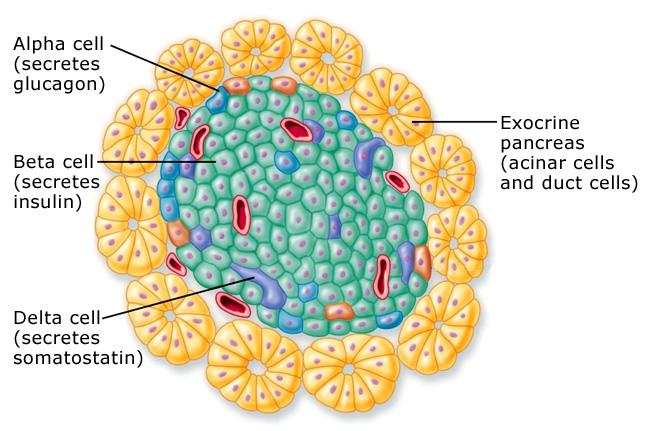 Pancreatic hormones
Clusters of endocrine cells, the islets of Langerhans, are scattered throughout the exocrine tissue of the pancreas. Each islet has a population of alpha cells, which produce the hormone glucagon, and a population of beta cells, which produce the hormone insulin. Somatostatin inhibits secretion of (from delta cells) insulin and glucagon.
Pancreatic hormones
Clusters of endocrine cells, the islets of Langerhans, are scattered throughout the exocrine tissue of the pancreas. Each islet has a population of alpha cells, which produce the hormone glucagon, and a population of beta cells, which produce the hormone insulin. Somatostatin inhibits secretion of (from delta cells) insulin and glucagon. Pancreas is an endocrine gland with hormone secreting cells, which constitute 1.2% of its weight. Pancreas also produces bicarbonate ions and digestive enzymes, which are released into small ducts and carried to the small intestine via the pancreatic duct. Tissues and glands that discharge secretions into ducts are described as exocrine. Thus, the pancreas is a dual endocrine and exocrine gland with important functions in both the endocrine and digestive systems. Clusters of endocrine cells, the islets of Langerhans, are scattered throughout the exocrine tissue of the pancreas. Each islet has a population of alpha cells, which produce the hormone glucagon, and a population of beta cells, which produce the hormone insulin. Both of these protein hormones, like all endocrine signals, are secreted into the circulatory system.
The islets produce three hormones insulin, glucagon and somatostatin from three different kinds of cells called beta, alpha and delta cells respectively. Insulin controls carbohydrate metabolism and maintains proper sugar level in the blood. Insulin enables the cells to absorb glucose and use it or convert it into glycogen, thereby promotes glucose utilization by the body cells and stimulates deposition of extra glucose of the blood – as glycogen in liver and muscles. Glucagon is secreted from alpha cells and stimulates the breakdown of glycogen in the liver to glucose, thus it raises sugar level in the blood. Somatostatin inhibits secretion of (from delta cells) insulin and glucagon. Insufficient secretion of insulin causes diabetes.